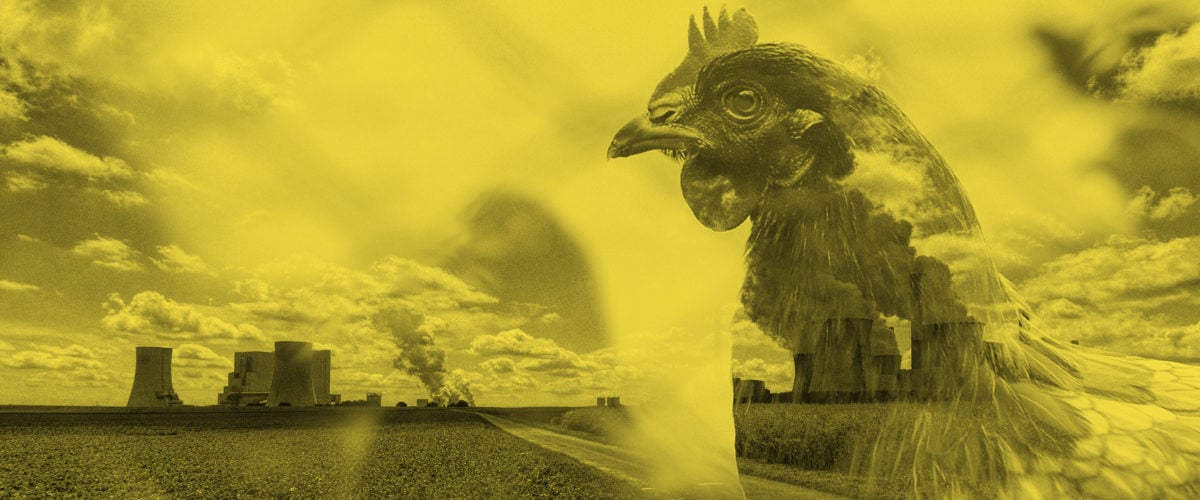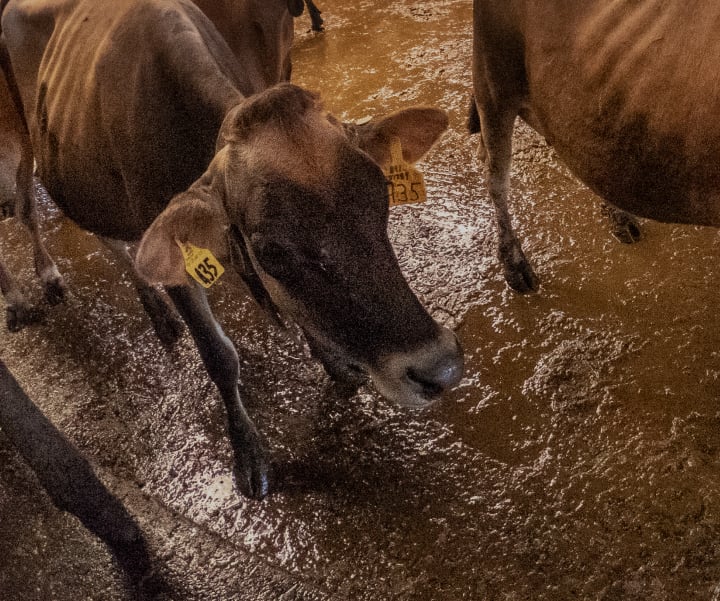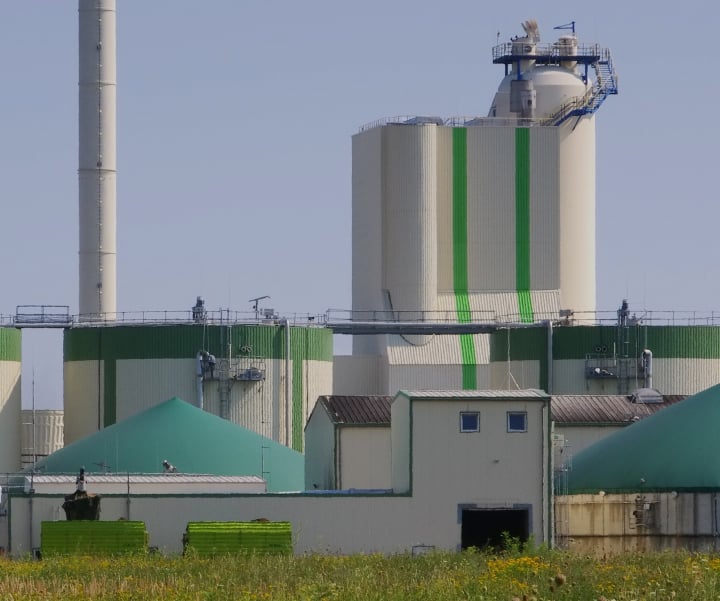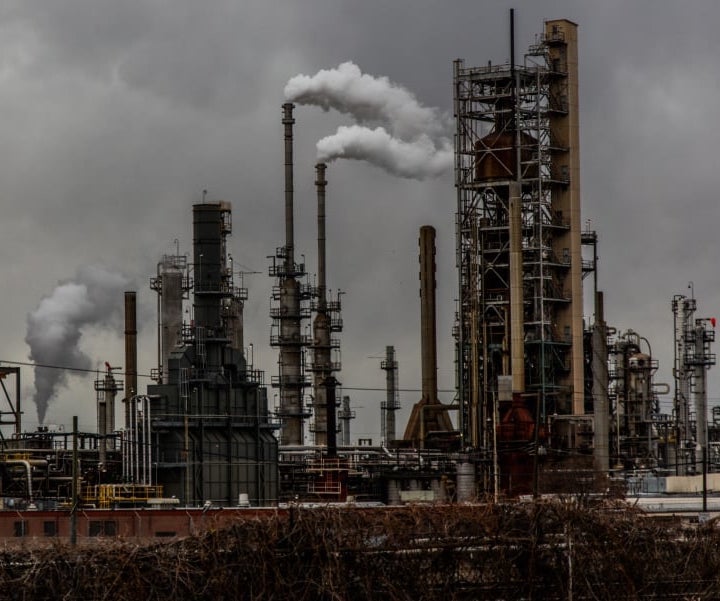We Can’t Let This Gas Greenwash Factory Farms
Published Apr 12, 2023

Despite what the industry says, factory farm gas isn’t clean, green, or renewable. Here’s what’s at stake for our communities and the climate.
Updated January 8, 2023.
Big Ag has a big waste problem. Every day, factory farms produce millions of tons of manure and other waste, which threatens our air, water, and climate. And though a new industry has grown claiming it will solve this problem, it will actually do way more harm than help.
Corporations — spearheaded by Ag and Oil giants — say they can turn all this factory farm waste into a “green” or even “renewable” energy source. At first glance, it might look like a neat fix: creating energy with waste, instead of fossil fuels. Backers say it’s a “win-win” — but they don’t tell you who loses.
Factory Farm Gas Is a Dirty Energy Source
Factory farm gas is a type of “biogas” — gas created from organic waste, like sewage and livestock manure, that can be burned for energy. However, seemingly planet-friendly labels like “biogas” or “renewable natural gas” are greenwashing this dirty energy source.
Though boosters like to gloss over this fact, factory farm gas is similar to fossil fuels in a lot of ways. For one, burning biogas produces the same air pollutants and contains impurities like ammonia, hydrogen sulfide, and smog-forming nitrogen oxides.
Moreover, gas facilities can continuously emit methane when they store digestate (the leftovers after waste is converted to gas) in open tanks. Then, when gas leaves those facilities, that produces even more emissions. It’s transported through the same supply chains and infrastructure as fracked gas.
This infrastructure — from pipelines to gas engines — leaks huge amounts of methane. In fact, the factory farm gas supply chain is even leakier than fossil gas. As a result, when real renewables like solar and wind are dropped in favor of factory farm gas, emissions increase, not decrease.
Expanding factory farm gas means entrenching and expanding fossil fuel infrastructure. It also creates new sources of climate-wrecking methane emissions. And, by tying the factory farm model to dirty energy production, expanding gas will double down on both.
Factory Farm Gas 101
Where does factory farm gas come from?
Factory farm gas starts with the waste of factory farms. The bigger the better — under economies of scale, factory farm gas makes more economic sense the bigger the operation and the more animals’ waste collected. This waste includes the manure as well as urine, blood, feathers, and straw bedding that collects in a hog, dairy, or poultry facility. It can also carry antibiotics, pathogens, and toxic chemicals.
SCROLL SIDEWAYS TO NAVIGATE

Factory Farm Gas 101
How does the waste turn into gas?
That waste is processed in an anaerobic digester: an oxygen-less tank or lagoon where microorganisms “eat” the waste. They leave behind a mixture of mostly carbon dioxide and methane. The methane can be burned for energy. They also produce some leftover solid waste called “digestate.”

Factory Farm Gas 101
How does industry use the gas?
Companies can use the gas either directly to generate electricity or heat, or they can refine it further. The refined product, called “biomethane,” is mostly used as vehicle fuel. If all this sounds familiar, that’s because factory farm gas and fossil gas are chemically similar and used in the same ways. They’re both primarily methane — a climate pollutant with 80 times the warming impact of carbon dioxide. Like fossil gas, gas from factory farms can be shipped via pipeline and used to generate power.

Factory Farms Worsen Our Manure Problem
Livestock waste is a major source of pollution in the United States, in great part because of how factory farms store and dispose of it. Most hog and dairy farms store their untreated waste in open-air lagoons. These lagoons increase methane emissions and send harmful pollutants like ammonia and hydrogen sulfide into the air.
Factory farm waste is also one of the biggest sources of nitrogen and phosphorus pollution in our waterways. This can make water undrinkable and cause algae blooms that kill aquatic life en masse.
Many of these hazards stem from the common industry practice of spreading untreated waste on fields. The untreated waste, full of toxic chemicals and pathogens, runs off of fields and into waterways.
Despite industry claims, digesters don’t actually fix these problems. In fact, they’re more likely to worsen them.
Digesters don’t eliminate or even reduce factory farm waste. They extract the methane but leave behind digestate, which is just the manure and other pollutants in a solid, more concentrated form. Digestate gets spread on fields just like liquid waste, causing much of the same health and environmental problems.
Factory Farm Gas Doubles Down on Environmental Injustice
When companies build factory farms, they bring all their pollution and health hazards with them. Factory farm pollution is linked to respiratory conditions, reduced lung function, higher blood pressure, waterborne illnesses, and more.
These impacts disproportionately endanger low-income communities and communities of color. Companies know that these communities don’t have the resources or political clout to stop them from setting up shop.
For example, a proposed factory farm gas facility in Sussex County, Delaware, threatens an already disadvantaged area. For folks living in a three-mile radius, over a third experience poverty, compared to 12% for the whole county. Moreover, about a third of people in that area are people of color, compared to 17% for the county as a whole.
For communities like those in Sussex, the expansion of factory farm gas means not only more pollution, but also higher risks of accidents. Factory farm gas pipelines — a part of almost all major projects — come with more risks compared to fossil gas lines. Gas from factory farms is more toxic and corrosive, and changes in pressure lead to greater chances of pipeline bursts.
Our Taxpayer Dollars Boost Pollution — and Profits for Big Ag and Big Oil
Digesters are hugely expensive, and most aren’t financially viable without taxpayer subsidies. A study of one California digester found that 90% of its revenue came from selling government credits, not actually selling its gas on the market.
In recent years, state and federal governments have offered a windfall of subsidies to encourage more digesters on factory farms.
The Inflation Reduction Act extended renewable tax credits to put “qualified” factory farm gas projects on the same footing as wind and solar. The Biden administration’s Methane Emissions Reduction Plan includes public-private partnerships for factory farm gas.
At the same time, states like Maryland and California have subsidized factory farm gas through renewable energy programs. By declaring this gas “renewable,” they’ve sent millions of taxpayer dollars to factory farms and developers.
These programs don’t incentivize responsible manure management or encourage farms to minimize their waste. They also don’t help smaller farms — the expensive equipment means that only bigger farms can invest in digesters and break even. That also means bigger farms are better positioned to benefit from subsidies.
Moreover, subsidies allow dirty industries to pull public dollars that could fund truly clean, green, and renewable energy. That includes some of our country’s biggest Ag and Oil giants, which are helping the growth of factory farm gas.
Meat corporation Smithfield and oil corporations Chevron and BP have all poured billions of dollars into development. That includes snatching up digester companies, cutting deals with gas utilities, and going after public funding.
By creating a market for manure, the factory farm gas industry — and the government subsidies it receives — incentivize more waste and bigger factory farms. With our taxpayer dollars, Big Ag and Big Oil are financing more sickening pollution and more dangerous emissions.
Learn more about the links between Big Oil and factory farm gas in our new report!
We Don’t Need Factory Farm Gas — We Need to End Factory Farming
Factory farm gas doesn’t solve the waste problem; it just makes new ones. That’s because it doesn’t address the problem at its source. Our food system could much more effectively reduce factory farm pollution (including climate pollution) with better waste management practices — or, better yet, by shutting down factory farms.
We can’t let the factory farm gas industry lie and sway our elected officials. We need to end digester subsidies, end factory farming, and stop new gas projects — including factory farm gas and fracked gas.
Replacing old dirty energy with new dirty energy won’t save the climate or communities. A full transition to truly green energy, like wind and solar, will.
Help us fight for an end to factory farms and a fairer food system! Urge your members of Congress to support the Farm System Reform Act.
Enjoyed this article?
Sign up for updates.
TO TOP


